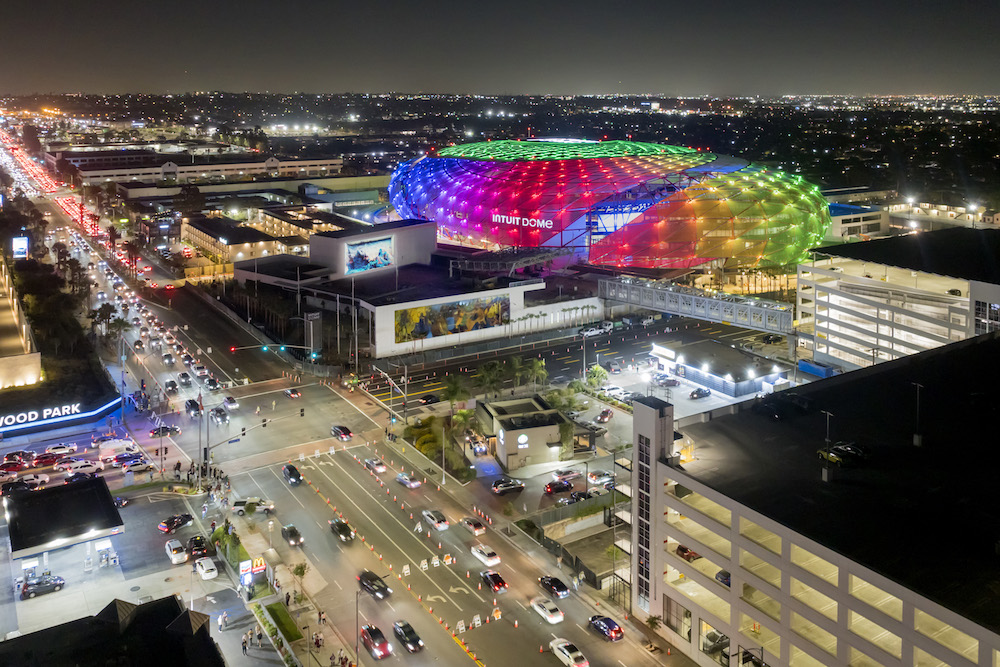There are few places on this earth where I have stood and felt humbled, in awe of the grandeur of human achievement, where art and architecture intentionally merge with consideration of form and function—and where sexy-ass aesthetics rule the day. These sites are what the contemporary canon looks to as pinnacles of achievement, moments that defined the human race, where the construction ambitions of those in power were matched by the artistic prowess of the craftsman tasked with fulfilling those lofty dreams.
This past week, I sat anonymously in the crowd as art consultant Ruth Berson (formally deputy director of curatorial affairs at SFMOMA) gave a speech to a small group gathered in a cavernous interstitial space between the faceted skin of the Intuit Dome and the actual entrance to the arena. This odd space is voluminous, containing artistically illuminated escalators and polygonal openings in the facade, allowing the planes landing at LAX to interrupt and interject into Berson’s speech and the environment as a whole. I was blindsided by my emotions as this seemed to be the most unlikely of locales. Formally, it could be defined as a multibillion-dollar sports arena, the new home of the Los Angeles Clippers, the location where the upcoming LA Olympics 2028 will host basketball games and where Bruno Mars will perform in a couple weeks for the official grand opening. Those are the practical functions of the space, but conceptually—and in almost a more important double agent status—are the aesthetics, the form, the intangible community.
The list of contributors to this impressive public art collection is already lengthy and touted, all of them having significant ties to the LA region. Jonas Wood designed the actual basketball court and Clippers’ uniforms; Charles Gaines has a large work yet to be unveiled and Catherine Opie has a series of LA-centric images being shown within the stadium. The exterior of the expansive new structure includes several other monumental murals. In the interest of transparency, I was a part of the flagship sculpture that welcomes patrons into the Dome—a 60-plus-foot Clipper ship in which the sails are transformed into basketball backboards.
The reason I was reverential was not because of what I knew about this project, but rather what I did not. I was in awe of the scope and vision with which this was conceived. This is not a handful of shiny sculptures plopped in a plaza to reflect the sky, but rather monumental works that thoughtfully intersect our community—each oddly thematic in their own obvious or subtle way. What stole my attention were the monumental digital works by Refik Anadol and Jennifer Steinkamp.

Jennifer Steinkamp, Swoosh, 2024. Lights built into the building skin. Commissioned by the LA Clippers for Intuit Dome. Photo by Iwan Baan.
After crossing the new pedestrian bridge and entering the Intuit Dome, I was grabbed by Anadol’s digital paintings, titled Living Arena (2014), rippling in the distance—the artwork exists as the back wall of a public basketball court in the exterior plaza. On a monumental LED screen (40 x 70 feet), it was undeniably more impressive as I got closer, but the real magic happened later. After the introductions, speeches and public thank yous, guests were released to peruse the complex, explore the art, socialize, drink champagne and shoot hoops in front of Anadol’s work. As the silhouettes of the patrons athletically danced in the foreground of the undulating AI paintings, that special and unexpected thing happened in which art, architecture and the viewer merged into something worth so much more than the sum of its parts. The interaction of scale, humans and relevant data merged into a 3D digital art ballet. Who knew that watching AI-generated data points bounce around on a humongous screen in some contemporary version of Pong would be so entertaining.
I was enthralled with the imagery produced as the sun set in the plaza, but with the darkness, my attention turned to the master-jewel. With the night came the true effect of the Steinkamp’s Swoosh (2024). It is somewhat hard to view in its entirety without either a private helicopter or on an LA flight—because it is the building. Berson regarded Steinkamp’s art in the most poetic way: “You could call the roof (of the dome) her canvas, and the embedded lights her pigment.”
In a night filled with contradictions, I left feeling artistically hopeful for once. Who the hell would have thought that I would be so impressed at a privately funded basketball arena complex because of the art?
So if you happen to be in first class flying out of LAX at night—raise a glass of champagne, look out your window as the lights dance across the Intuit Dome’s facade and make a toast to the fact that I was once again proven wrong. There still is hope in the new millennium for form and function to unite on a grand scale.


